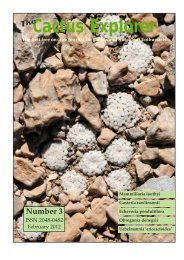Cactus Explorers Journal - The Cactus Explorers Club
Cactus Explorers Journal - The Cactus Explorers Club
Cactus Explorers Journal - The Cactus Explorers Club
Create successful ePaper yourself
Turn your PDF publications into a flip-book with our unique Google optimized e-Paper software.
<strong>The</strong> <strong>Cactus</strong> Explorer ISSN 2048-0482 Number 4 May 2012<br />
Fig.6 Four young plants of Lobivia kuehhasii GC409.01<br />
It was nine years later in 2009 that Walter<br />
Rausch published two new Lobivia names in<br />
the German journal KuaS, one of them, Lobivia<br />
kuehhasii is clearly the plant we saw in the<br />
Sierra Famatina and from near where we saw<br />
it.<br />
<strong>The</strong> type collection WR817b was made in<br />
1990 and in the WR field number list I have<br />
from 2008, it has the name Acanthocalycium<br />
thionanthum var. australis. I am not convinced<br />
that it is a separate species and I feel that a<br />
subspecies of E. thionantha would be more<br />
appropriate, bearing in mind its geographic<br />
disjunction.<br />
You may be wondering when I will tell you<br />
about the Maihueniopsis! Well, it was our next<br />
stop at 2755m. <strong>The</strong>re was some gently-sloping<br />
land (Fig.1) with a track leading down the<br />
slope from the road to a small building. We<br />
parked by the building where we could look<br />
down into a dramatic gorge with a river at the<br />
bottom (Fig.8). <strong>The</strong> water was an ochre colour<br />
which looked as if it originated from the soft<br />
rocks of the ravine.<br />
We looked around and I was interested to see<br />
a plant that looked like a small Echinopsis<br />
(Lobivia) formosa but already flowering when<br />
less than 15cm in diameter (Fig. 9). Nearby we<br />
had seen the normal form of the plant,<br />
growing to a large size and becoming short<br />
columnar. I concluded that this miniature form<br />
was the plant described by Rausch (1979) as<br />
Lobivia rosarioana, a name he later made a<br />
variety of Lobivia formosa. He tells us that the<br />
plant is rarely found in the Sierra Famatina.<br />
10<br />
Fig.7 Seedling of Lobivia kuehhasii GC409.01. 8cm pot.<br />
Fig.8 <strong>The</strong> ravine with the ochre-coloured river.<br />
Fig.9 Lobivia formosa rosarioana A small-growing form<br />
which flowers when only about 10cm in diameter.




